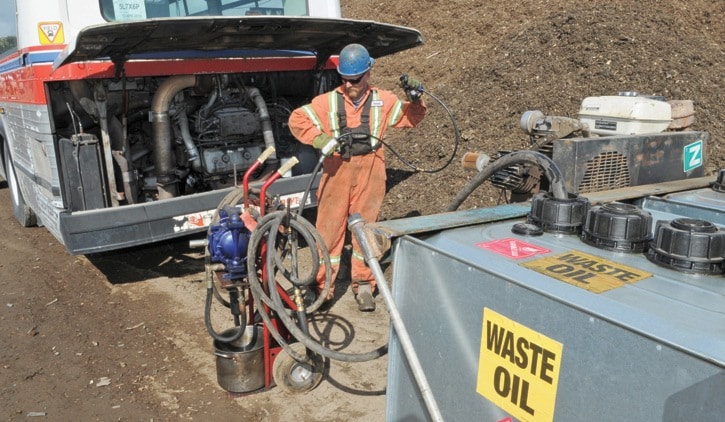The antiquated B.C. Transit bus pulls into its last-ever stop on time: precisely 10 a.m. Despite a full life serving the public, today the metal workhorse carries no passengers, not even a driver, as it’s towed to the Victoria scrapyard where transit buses go to die.
The MCI Classic, purchased new in 1989 for $187,500, spent 20 years – upwards of 18 hours a day, seven days a week – on Greater Victoria’s roads. In total, it racked up some 1.5 million kilometres, although nobody knows the exact number – the odometer broke years ago.
“The engine on this vehicle has water in the sump. That’s a sign of a major failure,” says Aaron Lamb, executive director of asset management for B.C. Transit. “Could we repair it? Absolutely, you can always repair it. But from an environmental, social and financial standpoint it doesn’t make sense to do that.”
This bus is one of the oldest – if not the oldest – in B.C. Transit’s provincial fleet.
As per B.C. Transit standards, it was taken off the road in 2009, 20 years after it was purchased. But it still had some life in it, so it remained in the provincial contingency fleet for a couple years – until it was towed to the scrap yard just north of the Bay Street Bridge last month.
Amid an acreage of bald tires, crushed sedans and shredded metal, workers at Schitnzer Steel’s Steel Pacific Recycling begin taking immediate environmental precautions on the well-kept transit bus.
“Any leakage is captured,” says Jenny Farkas, spokesperson for Schnitzer Steel as she and Lamb watch employee Derek Vowles pump all the fluids out of the engine. The batteries and mercury switches are removed, and the engine is pulled out.
Eventually cleansed of liquid toxins, the bus is pushed into place across the yard and comes to a stop between an excavator and a multiple-storey-tall metal baler.
And with almost no effort at all, and no moment of silence to recognize the bus’s decades of service, the bucket of the excavator slams through the roof of the transit bus, crunching the front end and tearing it to shreds.
The windshield shatters into pebbles of glass, as the bucket rips down through the steering console. The excavator operator picks up the destroyed front end and swivels it into the adjacent baler, which packages the twisted shards of metal and aluminum into a four-foot by four-foot brick.
In a matter of minutes, Lamb, in awe as he records the destruction on his cellphone, has one less recognizable asset to manage for B.C. Transit. The once 12-metre long bus is all condensed now into a few bales of metal.
It will be loaded onto a barge and floated down to Schnitzer’s main shredder in Tacoma, Wash., where all the pieces will be sorted and the majority recycled.
“We have an amazingly high recovery rate around vehicle recycling. We can extract finer and finer pieces of all these materials,” Farkas says.
Lamb conducts lifecycle analyses on all the province’s buses on a regular basis.
“Thirteen to 20 years from now, the buses could use 70 per cent less fuel than they do now. It might make environmental, social and economic sense then to accelerate our replacement process,” he says. “There are always new determinants.”
The technology in 1989-built bus pales to what’s standard today. There was no air conditioning, no digital signage boards, no wheelchair accessibility, not to mention it guzzled 9,000 litres more fuel each year, and produced an additional 23 tonnes of carbon dioxide.
“It really is a workhorse. … There’s a bit of nostalgia here,” Lamb says. “Think about all the people who were on it over 20 years – how many drivers, how many passengers, how many service people fuelled it.”
Never again will it be fuelled, or driven, or rode – at least in this incarnation. “Maybe it’ll be recycled into another bus,” Lamb says optimistically.
kslavin@saanichnews.com
